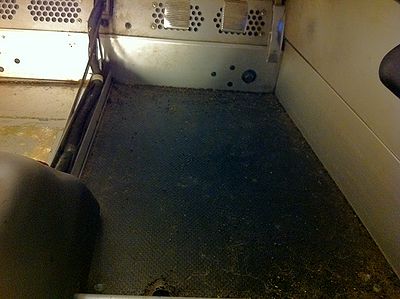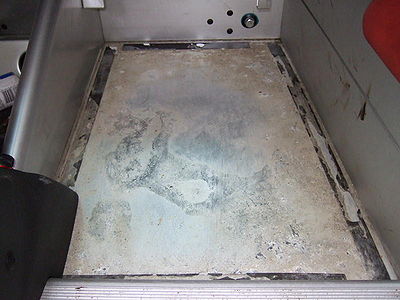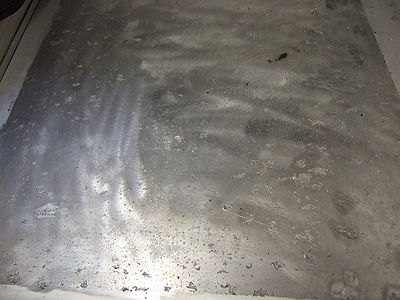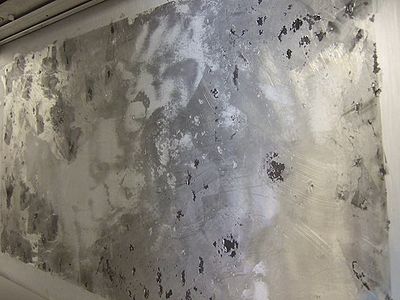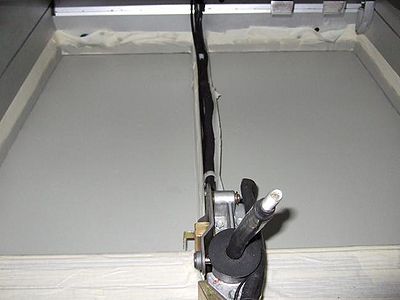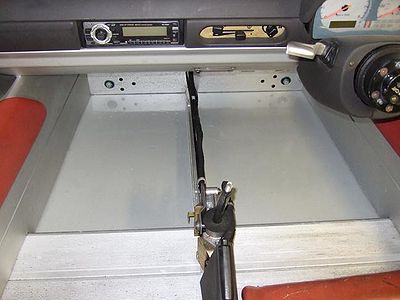Footwell Corrosion
Issue
Footwell corrosion is an issue which can affect S1 and early S2 Elises fitted with the bonded down rubber floor mats.
The non-breathable rubber floor mats can cause moisture and salts to become trapped against the floor which can then react with and corrode the aluminium floor.
The severity of this reaction can vary, from minor cosmetic marking of the floor to pitting, or at worse corroding through the floor panel.
Although this may sound bad, and while the floor panel is bonded in as part of the aluminium chassis around which the Elise is based, the floor panel itself is not a load bearing panel and even heavy corrosion can be repaired without necessitating a replacement chassis.
If your car is fitted with the rubber footwell mats it is strongly recommended to remove them immediately so that the floor condition can be assessed.
Cleaning and painting guide
By M111 - A Guide to cleaning and painting the footwell, from this thread - http://forums.seloc.org/viewthread.php?tid=141325&page=2#pid3004015
Step 1 - Mat Removal
Remove the original floor mats which are stuck down with double sided tape around the edges.
If possible find a loose edge and use this to pull the floor mat up, or use a Stanley knife to cut the mat in the centre - although if doing this be careful not to score the floor underneath. Do not try and lever the mat up against the kick plate at the front edge as a screwdriver or similar will mark the soft aluminium of the kick plate.
You can then see the extent of the corrosion, the white powder is where its starting to get bad & the black parts are were the anodizing has just been eaten away. There will probably be a few lumps where the worst corrosion is because it tends to pile up like a mole hill.
Step 2 - Cleaning
Give it a good clean up with a stiff brush and vacuum up the dust.
Next I used some alloy wheel cleaner which is basically detergent / acid mix & a stiff brush to scrub off as much of the of the remaining oxidized ally as possible, this does take quite a bit of time & effort to do, you will start to see how badly the corrosion has set in. Also I would advise working in a very well ventilated place or wearing a mask because the acid fumes can get a bit strong!
When I had got as much off as I could I then washed it all out with plenty of clean water to remove any traces of the acid, if this is left it will start to corrode the panel & any splashes on other parts of the chassis will leave a dull stain.
To remove all the corrosion from the pitting I used my Dremel with a stainless steel wire brush, this is also quite time consuming but has to be done very thoroughly to remove all the active corrosion.
You can see how bad it is once its all been cleaned away. What looks like a small spec of dust could be a deep hole once its cleaned up.
Step 3 - Filling
Remove the remains of the double sided tape from around the edge of the floor. I used a hot air gun, glue remover (solvent) and a razor blade scraper.
I made sure the floor pan was completely dry by leaving a small heater under the floor pan, this is important because you don't want to trap any moisture.
The pitting was then filled with some chemical metal which is just an epoxy type glue available from most DIY shops. I did this by scraping it in with a Stanley knife blade to leave a nice level finish. There was only 2 very small holes so I stuck some tape to the underside which stopped the glue from going all the way through, it can hardly be seen from the underneath.
Step 4 - Painting
To paint fully prepare and paint the floor you may want to pick up a POR15 Starter Kit, which contains appropriate marine cleaner, metal ready primer, and POR15 paint.
The floor needs a good clean with a solvent panel wipe to remove any dirt or oils that would react with the paint, you could probably use brake cleaner for this.
Most paints wont stick to aluminium very well so use the metal ready or a special primer is required. This is called an etch primer and contains acid to help it key into the surface. Some primers are a 2 part paint so needed to be mixed with an activator.
I applied 2 coats of primer with about half an hour gap between using a small foam roller to get a nice even & smooth finish. I would not recommend using aerosols because the over spay would go everywhere.
After being left to dry the prime needed to be lightly sanded with a fine Scotch Pad or Wet & Dry, then cleaned well with some panel wipe to remove any dust or dirt. If you were really fussy & wanted a perfect finish more coats of primer could have been put on giving a thicker coating which would allow the primer to be wet sanded to a perfect smooth surface for the paint. The final paint finish depends on the preparation.
The silver paint was then mixed up with a small amount of thinners and applied in the same way as the primer.
I gave it 3 coats this time and it seems to have covered well. Because of the cold weather I left a small heater under the car to help the paint dry.
If the time and effort is put in a perfect finish like the outside of a car can be achieved if that's what your after.
The main thing is the corrosion has been stopped so I shouldn't have any more problems with it.
Links
http://forums.seloc.org/p/3004015
http://forums.seloc.org/viewthread.php?tid=318085
http://hazelnet.org/corrosion/index.htm
